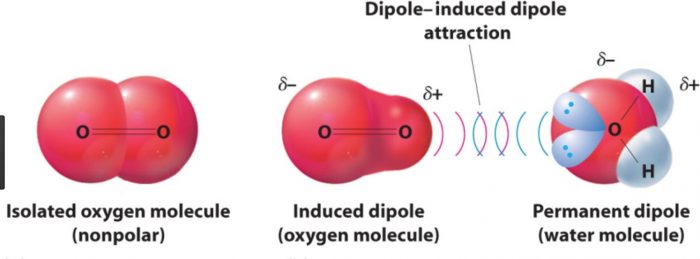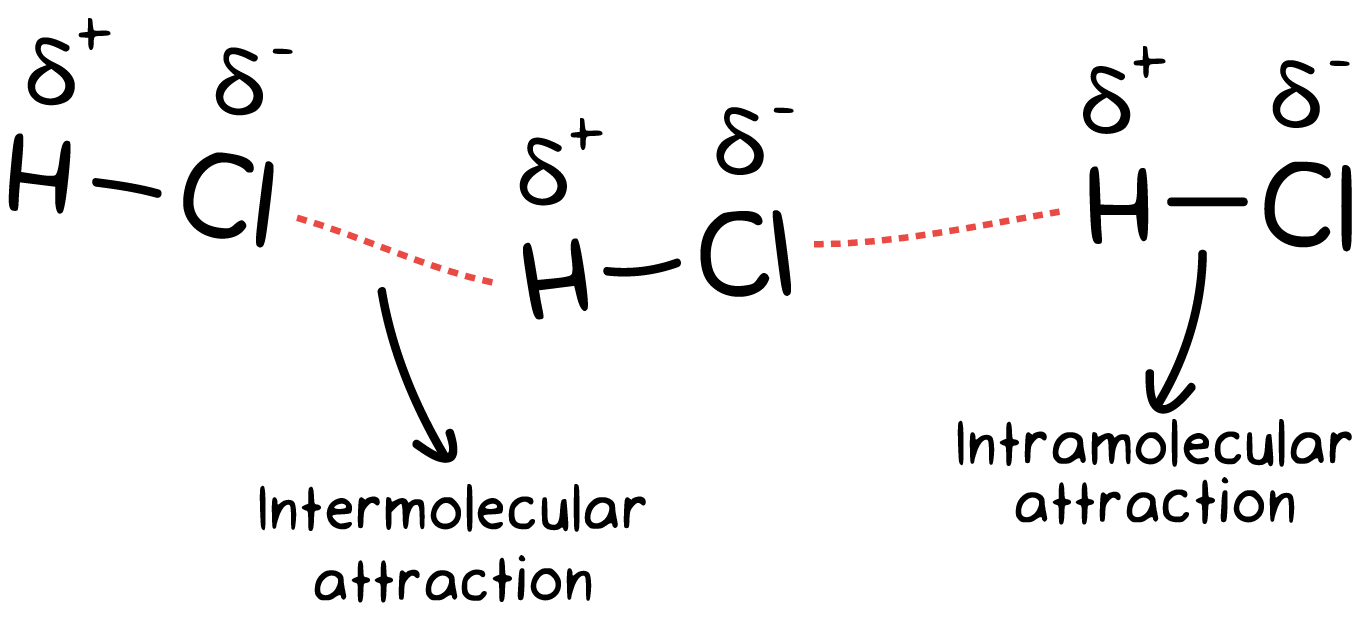Methane was scientifically identified in the year 1776 by Alessandro Volta. It is a greenhouse gas. It is flammable and is a component of biogas.Methane is lighter than air. Livestock and other farming activities are responsible for methane emissions into the environment.This article will explain the various types of intermolecular forces and focus on the intermolecular forces existing between methane molecules.So, what are the intermolecular forces between methane molecules? The intermolecular force of attraction between methane molecules is called the London force or dispersion force. This is because of the momentary development of polarity in an otherwise non-polar molecule.
Why do Methane (CH4) molecules interact by London Forces?
Methane is a non-polar molecule. The net dipole moment is zero.Due to the absence of a permanent dipole moment in methane, dipole-dipole forces and dipole-induced dipole forces are absent.Due to the continuous motion of electrons, the molecule develops instantaneous polarity when electrons are unsymmetrical about the nucleus. The next molecule develops an induced dipole due to the instantaneous dipole of the first molecule.Both the molecules are attracted to each other due to the presence of a temporary dipole moment.This type of force of attraction is called dispersion force or London force, or instantaneous dipole induced dipole force.
Factors affecting London forces
London forces are the weakest of Van der Waals forces. There are some factors due to which the extent of London forces differs in various compounds. The factors are1. Molecular size and weight– larger and heavier molecules have a greater extent of dispersion forces than smaller and lighter molecules.In larger molecules, the valence electrons are farther away from the nucleus, due to which they can form temporary dipoles relatively easily.For example, nonane has a greater extent of dispersion forces thane ethane.2. Polarizability- The ease of formation of a temporary dipole is called polarizability. Larger molecules are easily polarized. The extent of London forces is high in compounds that are easily polarized.For example, octane has a higher extent of dispersion forces than methane.3. Shape- Shape denotes the area of the molecule available for interaction. The larger surface area available indicates a larger extent of London forces.For example, n-pentane has a larger extent of London forces than neo-pentane.4. Distance– The intermolecular force is stronger when the molecules are nearby.For example, London force becomes negligible when the distance between interacting molecules is more than 500 pm.
Why is Methane (CH4) Non-Polar?
The polarity of a molecule is decided by the presence or absence of net dipole moment. The net dipole moment depends on-• The dipole moment of bonds• The difference in electronegativity between the atoms forming a bond• Geometry or symmetry of the moleculeIn methane, only one type of bond is present, and that is “C-H.”The electronegativity of C and H is 2.55 and 2.2, respectively. The difference comes out to be 0.35. It is not large, but we can say that the bonds are slightly polar.The vector sum of the dipole moments of all bonds in the tetrahedral geometry of methane comes out to be zero.Hence methane is non-polar due to the symmetry of the compound.
Why do Methane molecules not interact by hydrogen bonding?
Hydrogen bonding is a special type of dipole-dipole force. Since dipole moment is zero for methane, it does not exhibit dipole-dipole forces.Hydrogen bonding is observed when H is present in a compound with a highly electronegative element like F, O, and N. In this case, H is present along with C.
Types of Intermolecular Interactions
When two atoms or molecules interact, some repulsive or attractive forces are present between them. These forces are referred to as intermolecular forces.The attractive intermolecular forces that depend on inverse sixth power of separation between molecules are called Van der Waals forces. Van der Waals forces include
London forces or dispersion forces
These are the weakest Van der Waals forces. All molecules interact by London force, be it polar or non-polar. Other types of forces may or may not be present.It is developed due to the presence of instantaneous dipole moment. These forces are important only at short distances.For example, intermolecular forces between methane molecules.
Dipole-Dipole forces
It is the strongest Van der Waals forces. It is present between those molecules which have a permanent dipole moment.Partial charges are developed at the ends of a dipole, and the molecules are attracted towards each other. As the distance between molecules increases, the extent of force decreases.For example, intermolecular forces between HCl molecules.
Dipole induced- dipole forces
This type of interaction is present when one of the molecules is a permanent dipole while the other is not. The molecule with permanent dipole moment develops partial charges.These charges influence the non-polar molecule, and it develops an induced dipole moment by deforming the electron cloud.The interaction between these two dipoles is called dipole induced- dipole forces.For example, the intermolecular force between water and oxygen gas.Ion- Ion and ion-dipole interaction are attractive forces that depend on the inverse second power of separation between molecules.Ion-ion and ion-dipole interactions are stronger than Van der Waals forces because there is a complete separation of charge in ions. The dipoles have partial charges, so the forces are not strong enough.Order of intermolecular force of attractionIon-ion > ion-dipole> dipole-dipole > induced dipole-dipole > London forcesIn all these forces, the extent of attractive force increases with decreasing distance.When the distance decreases so much that the electron cloud and nuclei of two molecules start repelling each other, repulsive force is present instead of attractive force.
Intramolecular force Vs Intermolecular force
An intermolecular force of attraction or repulsion refers to the force between two molecules.Water exists in the form of a liquid because of intermolecular forces of attraction between water molecules.Intramolecular force refers to the force responsible for binding one molecule together. For example, Intramolecular force in methane- the covalent bond between C and H which makes the molecule Intermolecular force in methane- dispersive forces between two methane molecules.Below is an image showing intermolecular and intramolecular forces with the help of bonding in HCl compound.
Bonding in Methane (CH4)
Methane is a covalent molecule because the bonds are formed by sharing electrons, and the electronegativity difference is relatively small.In methane, bonding can be explained by using a concept called hybridization. Hybridization involves mixing atomic orbitals that are similar in size, shape, and energy. In methane, the central atom is carbon.The electronic configuration of carbon is 1s2 2s2 2p2. There are only two unpaired electrons.An electron is promoted from 2s to 2p, and the configuration becomes 1s2 2s1 2p3. Now, there are 4 unpaired electrons and 4 H-atoms.H-atom has 1s orbital for overlap while C has one 2s and three 2p. The overlap efficiency of s-s and s p is not the same. Thus, to explain the bonding efficiently, we use hybridization.The four inequivalent orbitals (one 2s and three 2p) combine to form four sp3 hybrid equivalent orbitals.Each H- atom overlaps with one sp3 hybrid orbital to form a sigma bond.It is a tetrahedral molecule.I have also written an entire specific blog related to bonding in CH4 molecules. Readout CH4 lewis structure.
Sources of Methane (CH4) Gas
• Fossil fuels are significant sources of methane gas• About 30 percent of methane gas comes from wetlands (including ponds, lakes, and rivers)• Termites produce methane gas daily.• Oceans are one of the natural sources of methane. About 10 percent of natural methane comes from oceans.• Composting- dead and decaying organic matter releases methane gas on decomposition.• Livestock farming- Animals release a large amount of methane during their digestion process.• Decomposition of sludge which is formed during water treatment• Burning of biomass• Methane is released during coal, natural gas, and oil production.
Uses
Methane finds its application in various fields. It is used in• Fertilizer• Antifreeze• Gas cookers• Automobiles (as fuel)• sanitization
Conclusion
Methane is an organic compound present in a gaseous state at room temperature.There are three categories of Van der Waals forces. Only one type of intermolecular force of attraction is present between methane molecules, which is the London force.The other two categories are dipole-dipole forces and dipole-induced dipole forces. Methane is a non-polar compound.Methane is a covalent compound with tetrahedral geometry and sp3 hybridization.Happy Reading!






